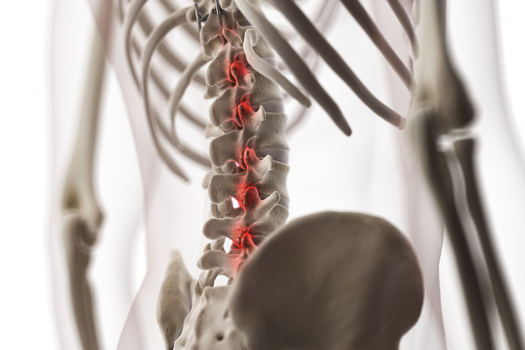
Lower back pain is common and somewhat complicated. For this reason, each person’s experience with spine-related issues in this area will be unique. However, there are some types of spine injuries that tend to be fairly common sources of lower back pain. This article discusses the types of lumbar spine injuries that could be the source of your symptoms and discomfort.
Muscle Strain
The lower back is highly mobile, which allows it to absorb much of the stress and strain from daily movements. Muscle strain is a common type of lumbar spine injury that results when spine-supporting muscles are overstressed enough to become irritated and inflamed. Lower back pain from muscle strain can produce symptoms that include:
• Sudden muscle spasms
• Pain triggered by certain movements
• Discomfort that becomes more noticeable after more strenuous activities
Other soft tissues that support the spine can become injured as well and contribute to noticeable discomfort. People can reduce their risk of lumbar spine injuries related to soft tissues by using proper techniques when lifting heavy items and making an effort to maintain good posture as they sit, stand, and sleep.
Herniated Discs and Other Spinal Disc Injuries
Since the lumbar spine isn't as well protected as other parts of the spine, it's common for discs in the lower back to become damaged. For example, a spinal disc in this area may eventually rupture and become a herniated disc. Lower back injuries of this type occur when inner disc material pushes through the outer shell of the disc. This becomes a problem if a nearby nerve is irritated by the protruding material. Spinal disc injuries can also involve:
• Discs that slip out of place
• Spinal discs that "bulge" or become abnormally shaped
• Discs damaged from forceful impacts or hard falls
Spinal Nerve Damage
Injuries impacting spinal nerves can also affect the lumbar spine. The most common spinal nerve injury involves the sciatic nerve. The longest nerve in the body, this nerve begins at the base of the spine and moves downward. If this nerve is irritated, it may cause an affected person to adjust his or her posture and shift his or her weight. Eventually these adjustments can place added stress on the lower spine, which could contribute to related disc or spinal joint damage.
Spinal Joint Issues
Facet joints connect vertebrae and allow for optimal flexibility and mobility in the lumbar spine area. These joints can be a source of lower back pain if they’re damaged, ruptured, or weakened in other ways. Injuries of this nature affecting spinal joints could contribute to:
• Localized lower back pain
• Radiating pain that extends to the lower body if a nearby nerve is irritated
• Stiffness or limited range of motion
Damage to Spinal Bones
Injuries affecting the lumbar spine can also be associated with vertebrae in this area. Spinal bones can be affected by vertebral fractures or a shift from a forceful impact—such as what might happen during contact sports or a car accident—that reduces spinal stability. Damage from arthritis or osteoporosis, a condition that weakens bones, can also contribute to injuries affecting any of the lower spinal bones.
Spinal Cord Injuries
In most severe cases, the spinal cord itself may be injured. If this occurs in the lower back area, a person may have limitations with movement or other potentially serious issues. In rare instances, certain types of cancer could also affect the part of the spinal cord that extends into the lower back.
If your back pain is severe and long-lasting, your doctor may recommend surgery to provide relief. For example, if you have a herniated disc that isn't responding to conservative treatment, a discectomy may be the best option. Although this is generally a very successful procedure, patients with a large hole in the outer ring of the disc have a significantly higher risk of reherniation following surgery. Often, the surgeon won’t know the size of the hole until beginning surgery, and having a large hole in the outer ring of the disc more than doubles the risk of needing another operation. A new treatment, Barricaid, is a bone-anchored device that closes this hole, and 95 percent of Barricaid patients didn’t undergo a reoperation due to reherniation in a 2-year study timeframe. This treatment is done immediately following the discectomy—during the same operation—and doesn’t require any additional incisions or time in the hospital.
If you have any questions about the Barricaid treatment, ask your doctor or contact us at 844-288-7474.
For full benefit/risk information, please visit: https://www.barricaid.com/instructions.


Comments